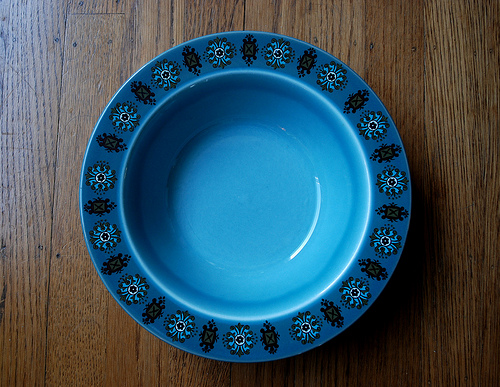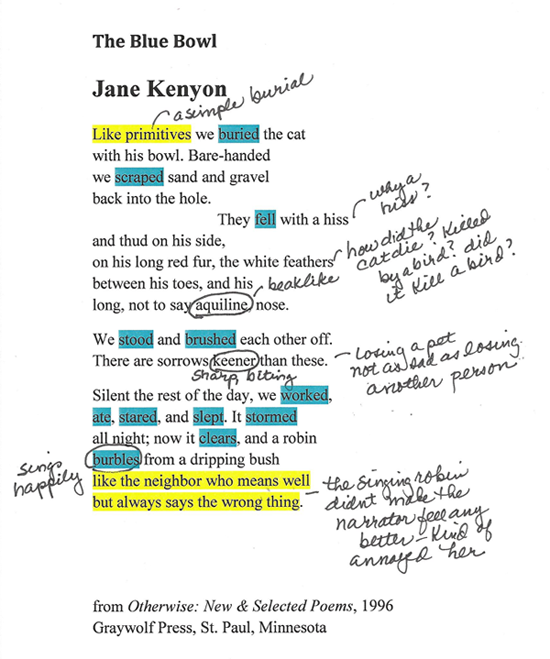
Source: tmp06094_1083.jpg, luminafoundation, Flickr
You have practiced your annotating skills with nonfiction texts, but it’s time to apply your knowledge of annotation to another kind of writing—a poem. You can also use the strategy found in this section to annotate fiction. The Jane Kenyon poem that you will annotate deals with the sad experience of burying a beloved pet.
Begin your annotation by using different colors of highlighters to identify different elements of the poem. Highlight similes in yellow and verbs in blue. Also circle unfamiliar words.
You can download the poem here. You can either print this file and use highlighters to annotate it, or you can use your software’s highlighting and drawing features if you prefer to do the exercise on-screen. When you are finished, return to this section and check your understanding to see a possible response.
The Blue Bowl
By Jane Kenyon

Source: TS & T Matador Serving Bowl, Peacock Modern, Flickr
Like primitives we buried the cat
with his bowl. Bare-handed
we scraped sand and gravel
back into the hole.
They fell with a hiss
and thud on his side,
on his long red fur, the white feathers
between his toes, and his
long, not to say aquiline, nose.
We stood and brushed each other off.
There are sorrows keener than these.
Silent the rest of the day, we worked,
ate, stared, and slept. It stormed
all night; now it clears, and a robin
burbles from a dripping bush
like the neighbor who means well
but always says the wrong thing.
What marginal notations could you write after highlighting and circling the text in the poem? I began by looking up the definitions of the circled words. The first word, “aquiline,” can mean “thin, curved, and pointed”—like an eagle’s beak. Kenyon’s word choice suggests that the cat’s owners thought he was a powerful, noble creature, so I would write this idea as a marginal notation. Now it’s your turn.
Read the meanings of the unfamiliar words in the questions that follow. Based on these definitions, respond to each question. You’ll want to note the meaning of each unfamiliar word in the margins of your poem.

- The word “keen” is an adjective that can mean “sharp and biting.” The speaker in the poem says, “There are sorrows keener than these,” meaning that the cat’s owners will suffer losses that are—
- Kenyon begins the poem with the simile “like primitives” in order to describe the way the cat’s owners bury their pet. A primitive (noun) can mean “someone from a culture with simple technologies.” Kenyon is suggesting that the burial was—
- In the last stanza, Kenyon lists the following verbs to illustrate how the cat’s owners spent “the rest of the day” after the cat’s burial: worked, ate, stared, slept. These verbs characterize the owners as—
- In the last stanza, Kenyon’s speaker pairs a stormy setting (“It stormed all night”) with a chirping robin who “burbles from a dripping bush” in order to create a parallel between her personal mourning and a world—
Return to your poem and reread it. Write questions that come to mind now that you know what some of the words mean and how Kenyon is using them. When you’re finished making notations, return to this section and check your understanding to see how I noted the meanings of unfamiliar words and used questions to figure out Kenyon’s poem.

For greater accessibility, download a PDF of this image.